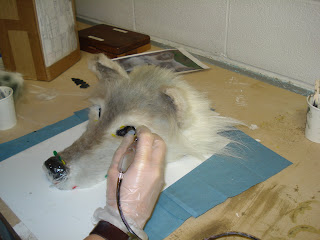I then contacted National Fiber Technology To ask them about suitable adhesives. They suggested a particular contact adhesive which unfortunately I could not find this particular product at short notice. Therefore I used evo stick the contact adhesive we have here. This worked fine. However, I now realise I shoud have sourced these kinds of products earlier in the project to prevent this last minute panic.
Once the underside was glued I trimmed away the edges.
With the underside in place I moved on to the claws. I sculpted the claws out of sculpy and then baked, painted and varnished them. Once they were dry I Glued them to the suede using the same contact ahesive. When the claws were in place I was then abe to trim away the remaining long fur from the paws.
With the body complete for finishing touches I moved on to the head.
I put the eyes in place and sealed them in with the tinsil gel 10. I then punched the whiskers.
I painted the teeth I cast with acrylics and used some black pigmented silicone to make a fleshy gum texture above the teeth.
I then secured these in place with more tinsil gel 10.
This was the last finishing touch I added to the model. However, Even though the project is finished I believe I may make alterations in time. This I shall discuss in my report.
Below is the Wolf skin as it is now





















